
| Version | Summary | Created by | Modification | Content Size | Created at | Operation |
|---|---|---|---|---|---|---|
| 1 | Melford Chuka Egbujor | -- | 3232 | 2023-04-27 11:03:04 | | | |
| 2 | Lindsay Dong | Meta information modification | 3232 | 2023-04-28 02:50:23 | | |
Video Upload Options
Several nitrogen heterocyclic analogues have been applied to clinical practice, and about 75% of drugs approved by the FDA contain at least a heterocyclic moiety. Thus, nitrogen heterocycles are beneficial scaffolds that occupy a central position in the development of new drugs. The fact that certain nitrogen heterocyclic compounds significantly activate the NRF2/ARE signaling pathway and upregulate the expression of NRF2-dependent genes, especially HO-1 and NQO1, underscores the need to study the roles and pharmacological effects of N-based heterocyclic moieties in NRF2 activation. Furthermore, nitrogen heterocycles exhibit significant antioxidant and anti-inflammatory activities. NRF2-activating molecules have been of tremendous research interest due to their therapeutic roles in neuroinflammation and oxidative stress-mediated diseases.
1. Introduction
2. Nitrogen Heterocycles as Modulators of the NRF2 Pathway
2.1. Five-Membered Nitrogen Heterocycles and NRF2 Activation
2.1.1. Pyrrolidine/Pyrroline Analogues
2.1.2. Pyrazoles
2.1.3. Imidazolidine/Imidazole Analogues
2.1.4. Triazoles
2.2. Six-Membered N-Heterocyclic Rings and NRF2 Activation
2.2.1. Piperidines
2.2.2. Pyridine Analogues
2.2.3. Pyrimidine and Pyrazine Analogues
2.2.4. Triazines
| S/N | Molecule/Structure | Effective concentration(s) | NRF2 Target Genes | Disease of Interest | Study Model | Biological Activity of Interest | Reference(s) |
|---|---|---|---|---|---|---|---|
| 1 | Pyrrolidine core Pyrrolidine-1-carbodithioic acid |
20 mg/kg | HO-1, NQO1, GCLM, GCLC | AD, Oxidative stress | Mice, Astrocytes | Antioxidant | [20] |
| 100 mg/kg | Infertility | Rats | Antioxidant, Anti-inflammatory | [48] | |||
| 50 mg/kg | GPx1, GPx4 | Inflammation bowel disease (IBD) | Mice | Antioxidant, Anti-inflammatory | [49] | ||
| 100 µM | NQO1, GCLM | Oxidative stress | HepG2 Cells | GCL induction, NRF2 localization | [50] | ||
| 1–10 µM | HO-1, NQO1, GCLM, GCLC | AD, Aβ toxicity | Mice | Antioxidant, neurogenesis | [51] | ||
| 2 | Pyrroline core (Z)-Methyl-4-(3,4-dihydroxybenzylidene)-2-methyl-5-oxo-1-phenethyl-4,5-dihydro-1H-pyrrolin-3-carboxylate. |
1 µM | HO-1, NQO1 | Neurodegenerative diseases | SH-SY5Y Cells | Antioxidant | [21] |
| 3 | Pyrazole core 1H-Pyrazole |
150 mg/kg | HO-1, GST | Liver injury, Oxidative stress | Mice | Antioxidant | [52] |
| 150 mg/kg | HO-1 | Oxidative stress | Mice | Antioxidant | [53] | ||
| 4 | 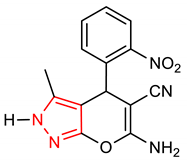 6-amino-3-methyl-4-(2-nitrophenyl) -2,4-dihydropyrano[2,3-c]pyrazole-5-carbonitrile |
0.3–30 µM | HO-1, NQO1 | AD, Oxidative stress | AREc32 Cells | Antioxidant, Anti-inflammatory | [23] |
| 5 | 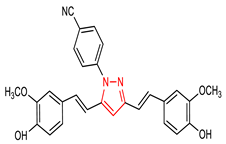 4-(3,5-bis((E)-4-hydroxy-3-methoxystyryl)-1H-pyrazol-1-yl)benzonitrile |
1.25–5µM | GPx | Oxidative stress | PC12 Cells | Antioxidant | [24] |
| 6 | Imidazole core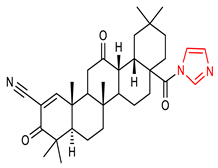 (4aR,6aS,12aS,12bS,14bR)-8a-(1H-imidazole-1-carbonyl)-4,4,6a,11,11,14b-hexamethyl-3,13-dioxo-3,4,4a,5,6,6a,6b,7,8,8a,9,10,11,12,12a,12b,13,14,14a,14b-icosahydropicene-2-carbonitrile |
50–200 mg/kg | HO-1, NQO1 | Lung cancer | Mice, RAW 264.7 Cells | Antioxidant, Anti-inflammatory | [25] |
| 30 µmol/kg | HO-1, NQO1, GCLC | Acute Kidney Injury | Mice | Antioxidant, Anti-inflammatory | [54] | ||
| 2 mg/kg | HO-1, NQO1, GCLC | Intestinal ischemia/reperfusion | Mice | Antioxidant, Anti-inflammatory | [55] | ||
| 7 | 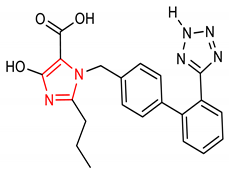 1-((2’-(2H-tetrazol-5-yl)-[1,1’-biphenyl]-4-yl)methyl)-4-hydroxy-2-propyl-1H-imidazole-5-carboxylic acid |
10 mg/kg | GPx | Chronic nephrotoxicity | Rats | Antioxidant, Anti-inflammatory | [56] |
| 8 | Triazole core 4-(3-nitrophenyl)-1-(m-tolyl)-1H-1,2,3-triazole |
10 µM | HO-1, NQO1 | Oxidative stress | HEK293 Cells, FP and NQO1 Assay | Antioxidant | [29] |
| 9 |  1-(3-iodophenyl)-4-(3-nitrophenyl)-1H-1,2,3-triazole |
10 µM | HO-1, NQO1 | Oxidative stress | HEK293 Cells, FP and NQO1 Assay | Antioxidant | [29] |
| 10 |  2-(1-(3,5-dimethylphenyl)-5-(2-hydroxyphenyl)-1H-1,2,4-triazol-3-yl)-5-(trifluoromethyl)phenol |
<400 mg/kg | HO-1, NQO1 | Ischemia stroke | Rats | Antioxidants | [31] |
| 11 | 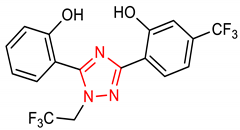 2-(5-(2-hydroxyphenyl)-1-(2,2,2-trifluoroethyl)-1H-1,2,4-triazol-3-yl)-5-(trifluoromethyl)phenol |
<1000 mg/kg | HO-1, NQO1 | Cerebral ischemic injury | Rats | Antioxidants | [30] |
| 12 |  4-(3-(2-hydroxy-4-methoxyphenyl)-5-(2-hydroxyphenyl)-1H-1,2,4-triazol-1-yl)benzenesulfonamide |
2.5–10 µM | GPx, SOD | Ischemic stroke | PC12 Cells | Antioxidant | [32] |
| 13 | Piperidine core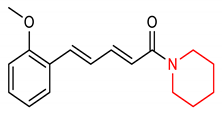 (2E,4E)-5-(2-methoxyphenyl)-1-(piperidin-1-yl)penta-2,4-dien-1-one |
100 mg/kg | HO-1, NQO1 | PD | PC12 Cells | Antioxiodant | [34] |
| 14 | 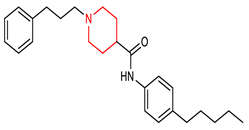 N-(4-pentylphenyl)-1-(3-phenylpropyl)piperidine-4-carboxamide |
E1/E2/E2 enzymes | Gastric cancer | MIGC803 Cells | Anticancer | [35] | |
| 15 | Pyridine core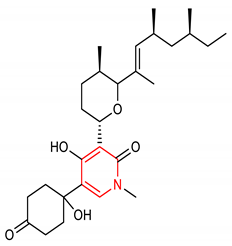 (+)-4,6-Anhydrooxysporidinone |
2.5 and 5 µM | HO-1 | Oxidative stress, apoptosis | HT22 cells | Antioxidant | [38] |
| 16 | 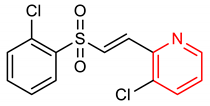 (E)-3-chloro-2-(2-((2-chlorophenyl)sulfonyl)vinyl)pyridine |
30 mg/kg | HO-1, GCLC, GCLM, SOD-1 | PD | Mice | Antioxidant, anti-inflammatory | [39] |
| 17 | Pyrimidine core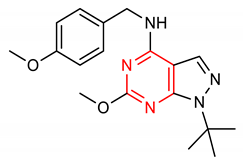 1-(tert-butyl)-6-methoxy-N-(4-methoxybenzyl)-1H-pyrazolo[3,4-d]pyrimidin-4-amine |
30 mg/kg | HO-1, NQO1, GCLM, | PD | Mice | Antioxidant, anti-inflammatory | [40] |
| 18 | 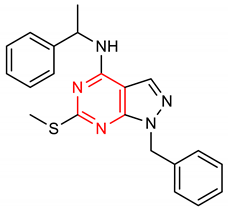 1-benzyl-6-(methylthio)-N-(1-phenylethyl)-1H-pyrazolo[3,4-d]pyrimidin-4-amine |
2000 mg/kg | HO-1, NQO1, GCLM, GCLC |
PD | Mice | Antioxidant, anti-inflammatory | [41] |
| 19 |  1-((3-(4-amino-3-methyl-1H-pyrazolo[3,4-d]pyrimidin-1-yl)phenyl)ethynyl)cyclohexanol |
20 µM | HO-1, NQO1 | Ischemia reperfusion injury | Mice | Antioxidant, anti-inflammatory | [42] |
| 20 | Pyrazine core tetramethyl pyrazine |
20 mg/kg | GCLC | PD | Mice | Antioxidant | [43] |
| 21 | Triazine core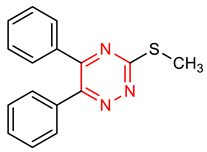 3-(methylthio)-5,6-diphenyl-1,2,4-triazine |
10 µM | HO-1, GPx1 | AD | PC12 Cells | Antioxidant | [46] |
| 22 | 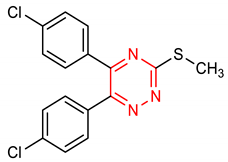 5,6-bis(4-chlorophenyl)-3-(methylthio)-1,2,4-triazine |
10 µM | HO-1, GPx1 | AD | PC12 Cells | Antioxidant | [46] |
| 23 |  5,6-bis(4-methoxyphenyl)-3-(methylthio)-1,2,4-triazine |
5–20 µ | HO-1, GPx1 | AD | PC12 Cells | Antioxidant, anti-inflammatory | [47] |
2.3. Fused/Condensed Nitrogen Heterocyclic Compounds
2.3.1. Indoles
| S/N | Molecule/Structure | Effective Concentration(s) | NRF2 Target Genes | Disease of Interest | Study Model | Biological Activity of Interest | Reference(s) |
|---|---|---|---|---|---|---|---|
| 24 | Indole core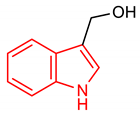 (1H-indol-3-yl)methanol |
20mg/kg | NQO1 | Prostate cancer | Mice | Antioxidant | [58] |
| 25 | 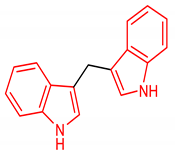 3,3′-diindolylmethane |
25–100 µM | NQO1, HO-1 | Oxidative stress | NIH3T3 Cells | Antioxidant | [59] |
| 5 µM | NQO1 | Prostate cancer | TRAMP mice, C1 Cells |
Antioxidant, Anticancer | [65] | ||
| 26 |  (3R,6S,12aR,13aR)-3-isopropyl-12a-methoxy-13a-methyl-6-(2-methylprop-1-en-1-yl)-2,3,13,13a-tetrahydro-1H-pyrazino[1’,2’:3,4]pyrimido[1,6-a]indole-1,4,12(6H,12aH)-trione |
10–50 µM | NQO1 | Oxidative stress | SH-SY5Y Cells | Antioxidant | [60] |
| 27 | 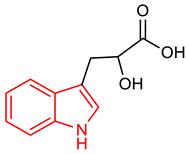 2-hydroxy-3-(1H-indol-3-yl)propanoic acid |
0.1–10 mM | NQO1, SOD-2, GPX-2 | Intestinal inflammation | Gut epithelial cells | Antioxidant, Anti-inflammatory | [61] |
| 28 | 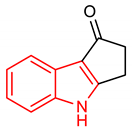 2,3-dihydrocyclopenta[b]indol-1(4H)-one |
0.1 µM | NQO1 | PD | SH-SY5Y | Antioxidant | [62] |
| 29 |  1-((4-methoxyphenyl)sulfonyl)-5-(((4-methoxyphenyl)sulfonyl)methyl)-2-methyl-N’-phenyl-1H-benzo[g]indole-3-carbohydrazide |
4–100 µM | NQO1 | Oxidative stress | MEF Cells, HepG2 Cells | Antioxidant | [63] |
| 30 | 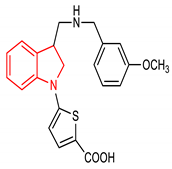 5-(3-(((3-methoxybenzyl)amino)methyl)indolin-1-yl)thiophene-2-carboxylic acid |
5 µM | NQO1 | Oxidative stress | HeLa Cells | Antioxidant | [64] |
| 31 | Quinazoline core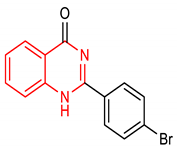 2-(4-bromophenyl)quinazolin-4(1H)-one |
15, 30 mg/kg | NQO1, HO-1 | Liver carcinogenesis | Rat | Antioxidant, Anticancer | [66] |
| 32 |  indolo[2,1-b]quinazoline-6,12-dione |
1 µM | HO-1, GCLC | Oxidative stress | HepG2 Cells | Antioxidant | [67] |
| 33 | Isoquinoline core (Z)-3-(2-(3-fluorophenyl)-2-oxoethylidene)-2,3,6,7-tetrahydro-1H-pyrazino[2,1-a]isoquinolin-4(11bH)-one |
10 µM | NQO1 | Oxidative stress | HepG2-ARE-C8 Cells | Antioxidant | [68] |
| 34 | 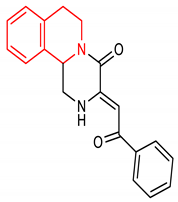 (Z)-3-(2-oxo-2-phenylethylidene)-2,3,6,7-tetrahydro-1H-pyrazino[2,1-a]isoquinolin-4(11bH)-one |
10 µM | NQO1 | Oxidative stress | HepG2-ARE-C8 Cells | Antioxidant | [68] |
| 35 |  7-fluoro-1,3-diphenylisoquinolin-1-amine |
10, 25 mg/kg | HO-1 | Amnesia, Oxidative stress | Mice | Anti-amnesic, Antioxidant | [69] |
| 36 | 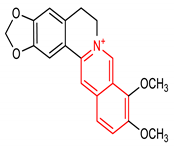 9,10-dimethoxy-5,6-dihydro-[1][70]dioxolo[4,5-g]isoquinolino[3,2-a]isoquinolin-7-ium |
50 mg/kg | NQO1, HO-1, SOD-1, CAT, GPx | Gouty arthritis | Rats | Antioxidant, anti-inflammatory | [71] |
| 37 | 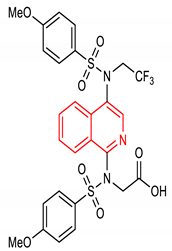 2-(4-methoxy-N-(4-(4-methoxy-N-(2,2,2-trifluoroethyl)phenylsulfonamido)isoquinolin-1-yl)phenylsulfonamido)acetic acid |
15 µM | NQO1 | Hepatic injury | U2OS Cells | Antioxidant, Hepatocellular protection | [72][73] |
2.3.2. Quinazolines
2.3.3. Isoquinolines
3. Structure–Activity Relationship of NRF2-Activating Nitrogen Heterocyclic Molecules
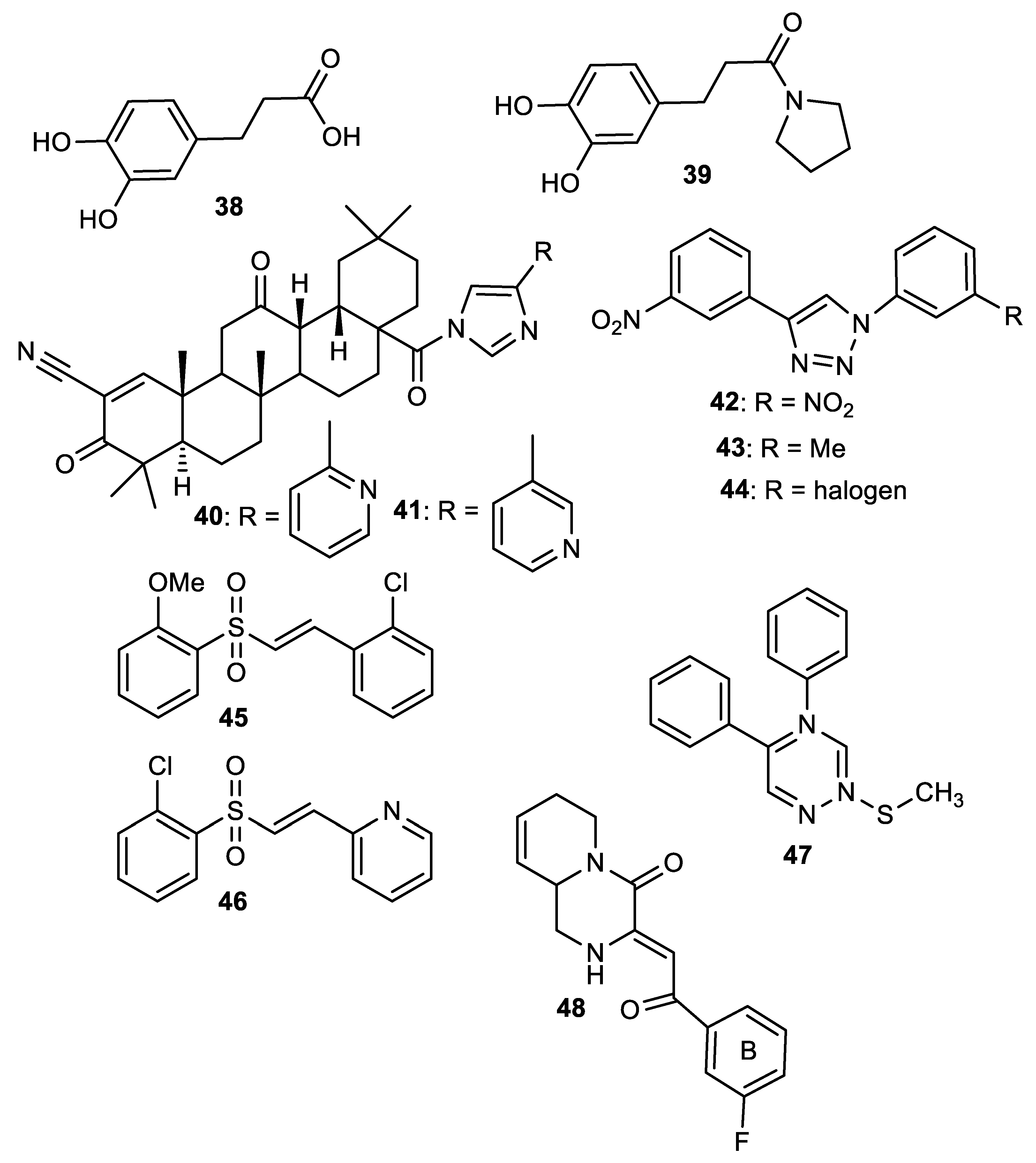
References
- Heravi, M.M.; Zadsirjan, V. Prescribed drugs containing nitrogen heterocycles: An overview. RSC Adv. 2020, 10, 44247–44311.
- Egbujor, M.C.; Egu, S.A.; Okonkwo, V.I.; Jacob, A.D.; Egwuatu, P.I.; Amasiatu, I.S. Antioxidant Drug Design: Historical and Recent Developments. J. Pharm. Res. Int. 2021, 32, 36–56.
- Egbujor, M.C.; Garrido, J.; Borges, F.; Saso, L. Sulfonamide a Valid Scaffold for Antioxidant Drug Development. Mini-Reviews Org. Chem. 2022, 20, 190–209.
- Egbujor, M.C.; Buttari, B.; Profumo, E.; Telkoparan-Akillilar, P.; Saso, L. An Overview of NRF2-Activating Compounds Bearing α,β-Unsaturated Moiety and Their Antioxidant Effects. Int. J. Mol. Sci. 2022, 23, 8466.
- Cores, Á.; Piquero, M.; Villacampa, M.; León, R.; Menéndez, J.C. NRF2 Regulation Processes as a Source of Potential Drug Targets against Neurodegenerative Diseases. Biomolecules 2020, 10, 904.
- Egbujor, M.C.; Saha, S.; Buttari, B.; Profumo, E.; Saso, L. Activation of Nrf2 signaling pathway by natural and synthetic chalcones: A therapeutic road map for oxidative stress. Expert Rev. Clin. Pharmacol. 2021, 14, 465–480.
- Sun, Z.; Chin, Y.E.; Zhang, D.D. Acetylation of Nrf2 by p300/CBP Augments Promoter-Specific DNA Binding of Nrf2 during the Antioxidant Response. Mol. Cell. Biol. 2009, 29, 2658–2672.
- Theodore, M.; Kawai, Y.; Yang, J.; Kleshchenko, Y.; Reddy, S.P.; Villalta, F.; Arinze, I.J. Multiple Nuclear Localization Signals Function in the Nuclear Import of the Transcription Factor Nrf2. J. Biol. Chem. 2008, 283, 8984–8994, Erratum in: J. Biol. Chem. 2008, 283, 14176.
- Jaramillo, M.C.; Zhang, D.D. The emerging role of the Nrf2–Keap1 signaling pathway in cancer. Genes Dev. 2013, 27, 2179–2191.
- Kansanen, E.; Kuosmanen, S.M.; Leinonen, H.; Levonen, A.-L. The Keap1-Nrf2 pathway: Mechanisms of activation and dysregulation in cancer. Redox Biol. 2013, 1, 45–49.
- Nioi, P.; Nguyen, T.; Sherratt, P.J.; Pickett, C.B. The Carboxy-Terminal Neh3 Domain of Nrf2 Is Required for Transcriptional Activation. Mol. Cell. Biol. 2005, 25, 10895–10906.
- Katoh, Y.; Itoh, K.; Yoshida, E.; Miyagishi, M.; Fukamizu, A.; Yamamoto, M. Two Domains of Nrf2 Cooperatively Bind CBP, a CREB Binding Protein, and Synergistically Activate Transcription. Genes Cells 2001, 6, 857–868.
- Rada, P.; Rojo, A.I.; Evrard-Todeschi, N.; Innamorato, N.G.; Cotte, A.; Jaworski, T.; Tobón-Velasco, J.C.; Devijver, H.; García-Mayoral, M.F.; Van Leuven, F.; et al. Structural and Functional Characterization of Nrf2 Degradation by the Glycogen Synthase Kinase 3/β-TrCP Axis. Mol. Cell. Biol. 2012, 32, 3486–3499.
- Wang, H.; Liu, K.; Geng, M.; Gao, P.; Wu, X.; Hai, Y.; Li, Y.; Li, Y.; Luo, L.; Hayes, J.D.; et al. RXRα Inhibits the NRF2-ARE Signaling Pathway through a Direct Interaction with the Neh7 Domain of NRF2. Cancer Res. 2013, 73, 3097–3108.
- Zhang, B.; Studer, A. Recent Advances in the Synthesis of Nitrogen Heterocycles via Radical Cascade Reactions Using Isonitriles as Radical Acceptors. Chem. Soc. Rev. 2015, 44, 3505–3521.
- Walsh, C.T. Nature loves nitrogen heterocycles. Tetrahedron Lett. 2015, 56, 3075–3081.
- Gordon, E.M.; Barrett, R.W.; Dower, W.J.; Fodor, S.P.A.; Gallop, M.A. Applications of Combinatorial Technologies to Drug Discovery. 2. Combinatorial Organic Synthesis, Library Screening Strategies, and Future Directions. J. Med. Chem. 1994, 37, 1385–1401.
- Baumann, M.; Baxendale, I.; Ley, S.; Nikbin, N. An overview of the key routes to the best selling 5-membered ring heterocyclic pharmaceuticals. Beilstein J. Org. Chem. 2011, 7, 442–495.
- Bhat, C.; Tilve, S.G. Recent advances in the synthesis of naturally occurring pyrrolidines, pyrrolizidines and indolizidine alkaloids using proline as a unique chiral synthon. RSC Adv. 2014, 4, 5405–5452.
- Liddell, J.R.; Lehtonen, S.; Duncan, C.; Keksa-Goldsteine, V.; Levonen, A.-L.; Goldsteins, G.; Malm, T.; White, A.R.; Koistinaho, J.; Kanninen, K.M. Pyrrolidine Dithiocarbamate Activates the Nrf2 Pathway in Astrocytes. J. Neuroinflammation 2016, 13, 49.
- Cores, A.; Abril, S.; Michalska, P.; Duarte, P.; Olives, A.; Martín, M.; Villacampa, M.; León, R.; Menéndez, J. Bisavenathramide Analogues as Nrf2 Inductors and Neuroprotectors in In Vitro Models of Oxidative Stress and Hyperphosphorylation. Antioxidants 2021, 10, 941.
- Schmidt, A.; Dreger, A. Recent Advances in the Chemistry of Pyrazoles. Properties, Biological Activities, and Syntheses. Curr. Org. Chem. 2011, 15, 1423–1463.
- Gameiro, I.; Michalska, P.; Tenti, G.; Cores, Á.; Buendia, I.; Rojo, A.I.; Georgakopoulos, N.D.; Hernández-Guijo, J.M.; Ramos, M.T.; Wells, G.; et al. Discovery of the first dual GSK3β inhibitor/Nrf2 inducer. A new multitarget therapeutic strategy for Alzheimer’s disease. Sci. Rep. 2017, 7, 45701.
- Liao, L.; Shi, J.; Jiang, C.; Zhang, L.; Feng, L.; Liu, J.; Zhang, J. Activation of anti-oxidant of curcumin pyrazole derivatives through preservation of mitochondria function and Nrf2 signaling pathway. Neurochem. Int. 2019, 125, 82–90.
- To, C.; Ringelberg, C.S.; Royce, D.B.; Williams, C.R.; Risingsong, R.; Sporn, M.B.; Liby, K.T. Dimethyl Fumarate and the Oleanane Triterpenoids, CDDO-Imidazolide and CDDO-Methyl Ester, Both Activate the Nrf2 Pathway but Have Opposite Effects in the A/J Model of Lung Carcinogenesis. Carcinogenesis 2015, 36, 769–781.
- Sussan, T.E.; Rangasamy, T.; Blake, D.J.; Malhotra, D.; El-Haddad, H.; Bedja, D.; Yates, M.S.; Kombairaju, P.; Yamamoto, M.; Liby, K.T.; et al. Targeting Nrf2 with the triterpenoid CDDO- imidazolide attenuates cigarette smoke-induced emphysema and cardiac dysfunction in mice. Proc. Natl. Acad. Sci. USA 2009, 106, 250–255.
- Paprocka, R.; Wiese, M.; Eljaszewicz, A.; Helmin-Basa, A.; Gzella, A.; Modzelewska, B.; Michalkiewicz, J. Synthesis and anti-inflammatory activity of new 1,2,4-triazole derivatives. Bioorganic Med. Chem. Lett. 2015, 25, 2664–2667.
- Pachuta-Stec, A. Antioxidant Activity of 1,2,4-Triazole and its Derivatives: A Mini-Review. Mini-Reviews Med. Chem. 2022, 22, 1081–1094.
- Bertrand, H.C.; Schaap, M.; Baird, L.; Georgakopoulos, N.D.; Fowkes, A.; Thiollier, C.; Kachi, H.; Dinkova-Kostova, A.T.; Wells, G. Design, Synthesis, and Evaluation of Triazole Derivatives That Induce Nrf2 Dependent Gene Products and Inhibit the Keap1–Nrf2 Protein–Protein Interaction. J. Med. Chem. 2015, 58, 7186–7194.
- Lao, Y.; Huang, P.; Chen, J.; Wang, Y.; Su, R.; Shao, W.; Hu, W.; Zhang, J. Discovery of 1,2,4-triazole derivatives as novel neuroprotectants against cerebral ischemic injury by activating antioxidant response element. Bioorganic Chem. 2022, 128, 106096.
- Lao, Y.; Wang, Y.; Chen, J.; Huang, P.; Su, R.; Shi, J.; Jiang, C.; Zhang, J. Synthesis and biological evaluation of 1,2,4-triazole derivatives as potential Nrf2 activators for the treatment of cerebral ischemic injury. Eur. J. Med. Chem. 2022, 236, 114315.
- Liao, L.; Jiang, C.; Chen, J.; Shi, J.; Li, X.; Wang, Y.; Wen, J.; Zhou, S.; Liang, J.; Lao, Y.; et al. Synthesis and biological evaluation of 1,2,4-triazole derivatives as potential neuroprotectant against ischemic brain injury. Eur. J. Med. Chem. 2020, 190, 112114.
- Abdelshaheed, M.M.; Fawzy, I.M.; El-Subbagh, H.I.; Youssef, K.M. Piperidine nucleus in the field of drug discovery. Futur. J. Pharm. Sci. 2021, 7, 188.
- Wang, L.; Cai, X.; Shi, M.; Xue, L.; Kuang, S.; Xu, R.; Qi, W.; Li, Y.; Ma, X.; Zhang, R.; et al. Identification and Optimization of Piperine Analogues as Neuroprotective Agents for the Treatment of Parkinson’s Disease via the Activation of Nrf2/Keap1 Pathway. Eur. J. Med. Chem. 2020, 199, 112385.
- Wang, B.; Zhang, Q.-H.; Li, X.-J.; Wang, S.-Q.; Chen, X.-B.; Yu, B.; Liu, H.-M. Discovery of a cinnamyl piperidine derivative as new neddylation inhibitor for gastric cancer treatment. Eur. J. Med. Chem. 2021, 226, 113896.
- Kotb, E.R.; Soliman, H.; Morsy, E.M.H.; Abdelwahed, N.A.M. New Pyridine and Triazolopyridine Derivatives: Synthesis, Antimicrobial and Antioxidant Evaluation. Acta Pol. Pharm. Drug Res. 2017, 74, 861–872.
- Chaban, T.; Matiychuk, V.; Chulovska, Z.; Myrko, I.; Drapak, I.; Sogujko, R.; Chaban, I.; Ogurtsov, V.; Nektegaev, I. Synthesis and Evaluation of Anti-Inflammatory Activity of Some Thiazolo Pyridines. Biointerface Res. Appl. Chem. 2021, 12, 7226–7238.
- Lee, D.; Choi, H.G.; Hwang, J.H.; Shim, S.H.; Kang, K.S. Neuroprotective Effect of Tricyclic Pyridine Alkaloids from Fusarium lateritium SSF2, against Glutamate-Induced Oxidative Stress and Apoptosis in the HT22 Hippocampal Neuronal Cell Line. Antioxidants 2020, 9, 1115.
- Choi, J.W.; Kim, S.; Yoo, J.S.; Kim, H.J.; Kim, B.E.; Lee, E.H.; Lee, Y.S.; Park, J.-H.; Park, K.D. Development and optimization of halogenated vinyl sulfones as Nrf2 activators for the treatment of Parkinson’s disease. Eur. J. Med. Chem. 2020, 212, 113103.
- Lee, J.A.; Kwon, Y.-W.; Kim, H.R.; Shin, N.; Son, H.J.; Cheong, C.S.; Kim, D.J.; Hwang, O. A Novel Pyrazolopyrimidine Induces Heme Oxygenase-1 and Exerts Anti-Inflammatory and Neuroprotective Effects. Mol. Cells 2022, 45, 134–147.
- Lee, J.A.; Kim, H.R.; Son, H.J.; Shin, N.; Han, S.H.; Chung, C.S.; Kim, D.J.; Hwang, O. A Novel Pyrazolopyrimidine KKC080106, activates the Nrf2 pathway and protetects nigral dopaminergic neurons. Exp. Neurol. 2020, 332, 113387.
- Mao, Y.; Lee, E.; Yang, X.; Bae, E.J.; Jeon, R.; Park, B.-H. Targeting p21-activated kinase 4 (PAK4) with pyrazolopyrimidine derivative SPA7012 attenuates hepatic ischaemia-reperfusion injury in mice. J. Enzym. Inhib. Med. Chem. 2022, 37, 2133–2146.
- Dai, L.; Diao, R.; Zhang, J.; Cao, M.; Gao, H.; Tang, B. Tetramethyl pyrazine exerts anti-apoptotic and antioxidant effects in a mouse model of MPTP-induced Parkinson’s disease via regulation of the expressions of Bax, Bcl-2, Nrf2 and GCLC. Trop. J. Pharm. Res. 2021, 20, 893–898.
- Reddy, M.; Rao, K.; Anusha, G.; Kumar, G.; Damu, A.; Reddy, K.R.; Shetti, N.P.; Aminabhavi, T.M.; Reddy, P.V.G. In-vitro evaluation of antioxidant and anticholinesterase activities of novel pyridine, quinoxaline and s-triazine derivatives. Environ. Res. 2021, 199, 111320.
- Marín-Ocampo, L.; Veloza, L.A.; Abonia, R.; Sepúlveda-Arias, J.C. Anti-inflammatory activity of triazine derivatives: A systematic review. Eur. J. Med. Chem. 2019, 162, 435–447.
- Khodagholi, F.; Ansari, N.; Amini, M.; Tusi, S.K. Involvement of Molecular Chaperones and the Transcription Factor Nrf2 in Neuroprotection Mediated by Para-Substituted-4,5-Diaryl-3-Thiomethyl-1,2,4-Triazines. Cell Stress Chaperones 2012, 17, 409–422.
- Tusi, S.K.; Ansari, N.; Amini, M.; Amirabad, A.D.; Shafiee, A.; Khodagholi, F. Attenuation of NF-κB and activation of Nrf2 signaling by 1,2,4-triazine derivatives, protects neuron-like PC12 cells against apoptosis. Apoptosis 2010, 15, 738–751.
- Delen, O.; Uz, Y.H. Protective effect of pyrrolidine dithiocarbamate against methotrexate-induced testicular damage. Hum. Exp. Toxicol. 2021, 40, S164–S177.
- Yin, J.; Wu, M.; Duan, J.; Liu, G.; Cui, Z.; Zheng, J.; Chen, S.; Ren, W.; Deng, J.; Tan, X.; et al. Pyrrolidine Dithiocarbamate Inhibits NF-KappaB Activation and Upregulates the Expression of Gpx1, Gpx4, Occludin, and ZO-1 in DSS-Induced Colitis. Appl. Biochem. Biotechnol. 2015, 177, 1716–1728.
- Zipper, L.M. Erk Activation Is Required for Nrf2 Nuclear Localization during Pyrrolidine Dithiocarbamate Induction of Glutamate Cysteine Ligase Modulatory Gene Expression in HepG2 Cells. Toxicol. Sci. 2003, 73, 124–134.
- Kärkkäinen, V.; Pomeshchik, Y.; Savchenko, E.; Dhungana, H.; Kurronen, A.; Lehtonen, S.; Naumenko, N.; Tavi, P.; Levonen, A.-L.; Yamamoto, M.; et al. Nrf2 Regulates Neurogenesis and Protects Neural Progenitor Cells Against Aβ Toxicity. STEM CELLS 2014, 32, 1904–1916.
- Lu, Y.; Gong, P.; Cederbaum, A.I. Pyrazole Induced Oxidative Liver Injury Independent of CYP2E1/2A5 Induction Due to Nrf2 Deficiency. Toxicology 2008, 252, 9–16.
- Cederbaum, A. Nrf2 and antioxidant defense against CYP2E1 toxicity. Expert Opin. Drug Metab. Toxicol. 2009, 5, 1223–1244.
- Liu, M.; Reddy, N.M.; Higbee, E.M.; Potteti, H.R.; Noel, S.; Racusen, L.; Kensler, T.W.; Sporn, M.B.; Reddy, S.P.; Rabb, H. The Nrf2 triterpenoid activator, CDDO-imidazolide, protects kidneys from ischemia–reperfusion injury in mice. Kidney Int. 2014, 85, 134–141.
- Huang, Y.; Ye, M.; Wang, C.; Wang, Z.; Zhou, W. Protective effect of CDDO-imidazolide against intestinal ischemia/reperfusion injury in mice. Eur. J. Inflamm. 2018, 16, 2058739218802681.
- Gounder, V.K.; Arumugam, S.; Arozal, W.; Thandavarayan, R.A.; Pitchaimani, V.; Harima, M.; Suzuki, K.; Nomoto, M.; Watanabe, K. Olmesartan protects against oxidative stress possibly through the Nrf2 signaling pathway and inhibits inflammation in daunorubicin-induced nephrotoxicity in rats. Int. Immunopharmacol. 2014, 18, 282–289.
- Taber, D.F.; Tirunahari, P.K. Indole synthesis: A review and proposed classification. Tetrahedron 2011, 67, 7195–7210.
- Wu, T.-Y.; Saw, C.L.-L.; Khor, T.O.; Pung, D.; Boyanapalli, S.S.; Kong, A.-N.T. In vivo pharmacodynamics of indole-3-carbinol in the inhibition of prostate cancer in transgenic adenocarcinoma of mouse prostate (TRAMP) mice: Involvement of Nrf2 and cell cycle/apoptosis signaling pathways. Mol. Carcinog. 2011, 51, 761–770.
- Ernst, I.M.A.; Schuemann, C.; Wagner, A.E.; Rimbach, G. 3,3′-Diindolylmethane but not indole-3-carbinol activates Nrf2 and induces Nrf2 target gene expression in cultured murine fibroblasts. Free. Radic. Res. 2011, 45, 941–949.
- Xiao, X.; Tong, Z.; Zhang, Y.; Zhou, H.; Luo, M.; Hu, T.; Hu, P.; Kong, L.; Liu, Z.; Yu, C.; et al. Novel Prenylated Indole Alkaloids with Neuroprotection on SH-SY5Y Cells against Oxidative Stress Targeting Keap1–Nrf2. Mar. Drugs 2022, 20, 191.
- Ehrlich, A.M.; Pacheco, A.R.; Henrick, B.M.; Taft, D.; Xu, G.; Huda, M.N.; Mishchuk, D.; Goodson, M.L.; Slupsky, C.; Barile, D.; et al. Indole-3-lactic acid associated with Bifidobacterium-dominated microbiota significantly decreases inflammation in intestinal epithelial cells. BMC Microbiol. 2020, 20, 357.
- Wei, P.-C.; Lee-Chen, G.-J.; Chen, C.-M.; Wu, Y.-R.; Chen, Y.-J.; Lin, J.-L.; Lo, Y.-S.; Yao, C.-F.; Chang, K.-H. Neuroprotection of Indole-Derivative Compound NC001-8 by the Regulation of the NRF2 Pathway in Parkinson’s Disease Cell Models. Oxidative Med. Cell. Longev. 2019, 2019, 5074367-15.
- Yasuda, D.; Yuasa, A.; Obata, R.; Nakajima, M.; Takahashi, K.; Ohe, T.; Ichimura, Y.; Komatsu, M.; Yamamoto, M.; Imamura, R.; et al. Discovery of benzoindoles as a novel class of non-covalent Keap1-Nrf2 protein-protein interaction inhibitor. Bioorganic Med. Chem. Lett. 2017, 27, 5006–5009.
- Cosimelli, B.; Greco, G.; Laneri, S.; Novellino, E.; Sacchi, A.; Amendola, G.; Cosconati, S.; Bortolozzi, R.; Viola, G. Identification of novel indole derivatives acting as inhibitors of the Keap1–Nrf2 interaction. J. Enzym. Inhib. Med. Chem. 2019, 34, 1152–1157.
- Wu, T.-Y.; Khor, T.O.; Su, Z.-Y.; Saw, C.; Shu, L.; Cheung, K.-L.; Huang, Y.; Yu, S.; Kong, A.-N.T. Epigenetic Modifications of Nrf2 by 3,3′-diindolylmethane In Vitro in TRAMP C1 Cell Line and In Vivo TRAMP Prostate Tumors. AAPS J. 2013, 15, 864–874.
- Bose, P.; Siddique, M.U.M.; Acharya, R.; Jayaprakash, V.; Sinha, B.N.; Lapenna, A.; Pattanayak, S.P. Quinazolinone derivative BNUA-3 ameliorated -induced liver carcinogenesis in SD rats by modulating AhR-CYP1B1-Nrf2-Keap1 pathway. Clin. Exp. Pharmacol. Physiol. 2019, 47, 143–157.
- Moon, S.Y.; Lee, J.-H.; Choi, H.Y.; Cho, I.J.; Kim, S.C.; Kim, Y.W. Tryptanthrin Protects Hepatocytes against Oxidative Stress via Activation of the Extracellular Signal-Regulated Kinase/NF-E2-Related Factor 2 Pathway. Biol. Pharm. Bull. 2014, 37, 1633–1640.
- Dai, H.; Jiao, Q.; Liu, T.; You, Q.; Jiang, Z. Development of Novel Nrf2/ARE Inducers Bearing Pyrazino Isoquinolin Scaffold with Potent In Vitro Efficacy and Enhanced Physicochemical Properties. Molecules 2017, 22, 1541.
- Müller, S.G.; Pesarico, A.P.; Rosa, S.G.; Martini, F.; Nogueira, C.W. Contribution of cholinergic system and Nrf2/HO-1 signaling to the anti-amnesic action of 7-fluoro-1,3-diphenylisoquinoline-1-amine in mice. Chem. Interact. 2020, 317, 108959.
- Kumar, A.; Singh, A.K.; Singh, H.; Vijayan, V.; Kumar, D.; Naik, J.; Thareja, S.; Yadav, J.P.; Pathak, P.; Grishina, M.; et al. Nitrogen Containing Heterocycles as Anticancer Agents: A Medicinal Chemistry Perspective. Pharmaceuticals 2023, 16, 299.
- Dinesh, P.; Rasool, M. Berberine, an isoquinoline alkaloid suppresses TXNIP mediated NLRP3 inflammasome activation in MSU crystal stimulated RAW 264.7 macrophages through the upregulation of Nrf2 transcription factor and alleviates MSU crystal induced inflammation in rats. Int. Immunopharmacol. 2017, 44, 26–37.
- Lazzara, P.R.; David, B.P.; Ankireddy, A.; Richardson, B.G.; Dye, K.; Ratia, K.M.; Reddy, S.P.; Moore, T.W. Isoquinoline Kelch-like ECH-Associated Protein 1-Nuclear Factor (Erythroid-Derived 2)-like 2 (KEAP1-NRF2) Inhibitors with High Metabolic Stability. J. Med. Chem. 2019, 63, 6547–6560.
- Naidu, S.D.; Suzuki, T.; Dikovskaya, D.; Knatko, E.V.; Higgins, M.; Sato, M.; Novak, M.; Villegas, J.A.; Moore, T.W.; Yamamoto, M.; et al. The isoquinoline PRL-295 increases the thermostability of Keap1 and disrupts its interaction with Nrf2. iScience 2022, 25, 103703.
- Jafari, E.; Khajouei, M.R.; Hassanzadeh, F.; Hakimelahi, G.H.; Khodarahmi, G.A. Quinazolinone and quinazoline derivatives: Recent structures with potent antimicrobial and cytotoxic activities. Res. Pharm. Sci. 2016, 11, 1–14.
- Xi, M.-Y.; Jia, J.-M.; Sun, H.-P.; Sun, Z.-Y.; Jiang, J.-W.; Wang, Y.-J.; Zhang, M.-Y.; Zhu, J.-F.; Xu, L.-L.; Jiang, Z.-Y.; et al. 3-Aroylmethylene-2,3,6,7-tetrahydro-1H-pyrazino isoquinolin-4(11bH)-ones as Potent Nrf2/ARE Inducers in Human Cancer Cells and AOM-DSS Treated Mice. J. Med. Chem. 2013, 56, 7925–7938.
- Ku, H.-C.; Lee, S.-Y.; Yang, K.-C.; Kuo, Y.-H.; Su, M.-J. Modification of Caffeic Acid with Pyrrolidine Enhances Antioxidant Ability by Activating AKT/HO-1 Pathway in Heart. PLoS ONE 2016, 11, e0148545.
- Silva, V.L.; Elguero, J.; Silva, A.M. Current progress on antioxidants incorporating the pyrazole core. Eur. J. Med. Chem. 2018, 156, 394–429.
- Cao, M.; Onyango, E.O.; Williams, C.R.; Royce, D.B.; Gribble, G.W.; Sporn, M.B.; Liby, K.T. Novel synthetic pyridyl analogues of CDDO-Imidazolide are useful new tools in cancer prevention. Pharmacol. Res. 2015, 100, 135–147.
- Schöffmann, A.; Wimmer, L.; Goldmann, D.; Khom, S.; Hintersteiner, J.; Baburin, I.; Schwarz, T.; Hintersteininger, M.; Pakfeifer, P.; Oufir, M.; et al. Efficient Modulation of γ-Aminobutyric Acid Type A Receptors by Piperine Derivatives. J. Med. Chem. 2014, 57, 5602–5619.
- Vitaku, E.; Smith, D.T.; Njardarson, J.T. Analysis of the Structural Diversity, Substitution Patterns, and Frequency of Nitrogen Heterocycles among U.S. FDA Approved Pharmaceuticals. J. Med. Chem. 2014, 57, 10257–10274.
- Pennington, L.D.; Moustakas, D.T. The Necessary Nitrogen Atom: A Versatile High-Impact Design Element for Multiparameter Optimization. J. Med. Chem. 2017, 60, 3552–3579.
- Griffith, R.; Bremner, J.B. Computational Evaluation of N-Based Transannular Interactions in Some Model Fused Medium-Sized Heterocyclic Systems and Implications for Drug Design. Molecules 2023, 28, 1631.




